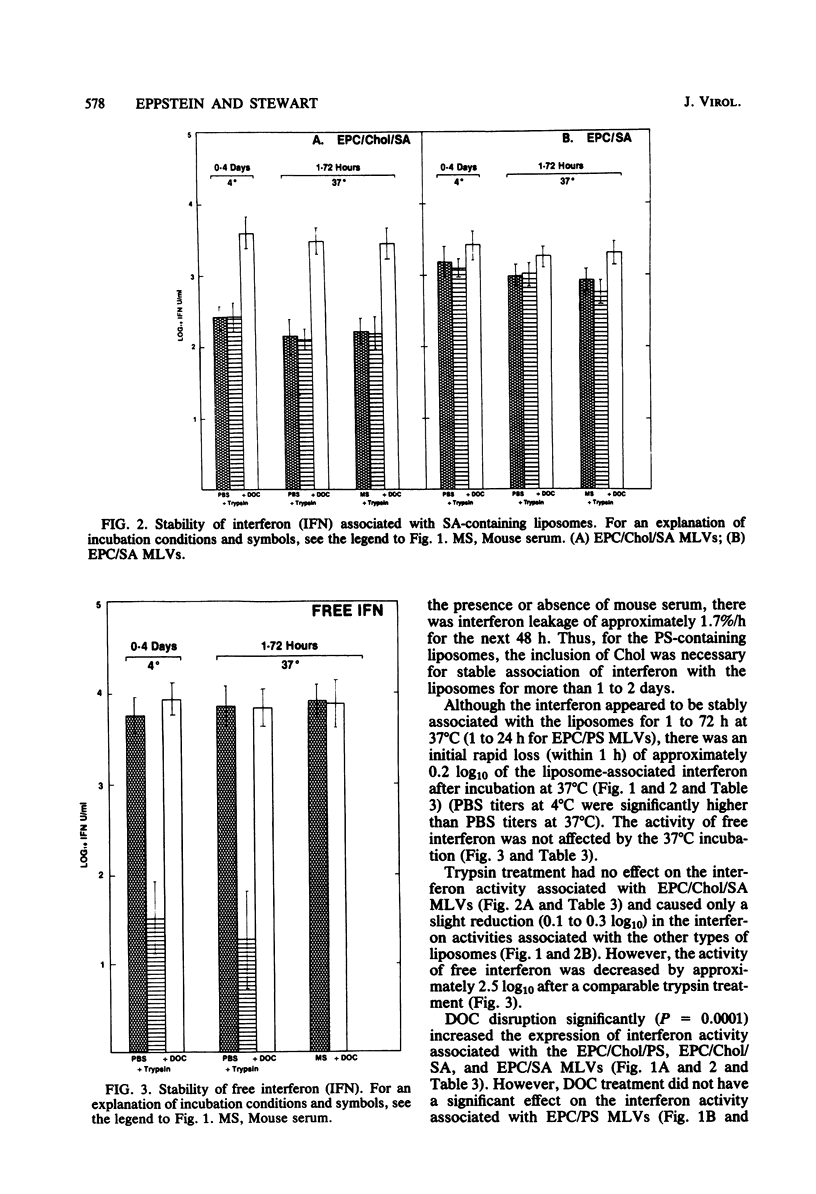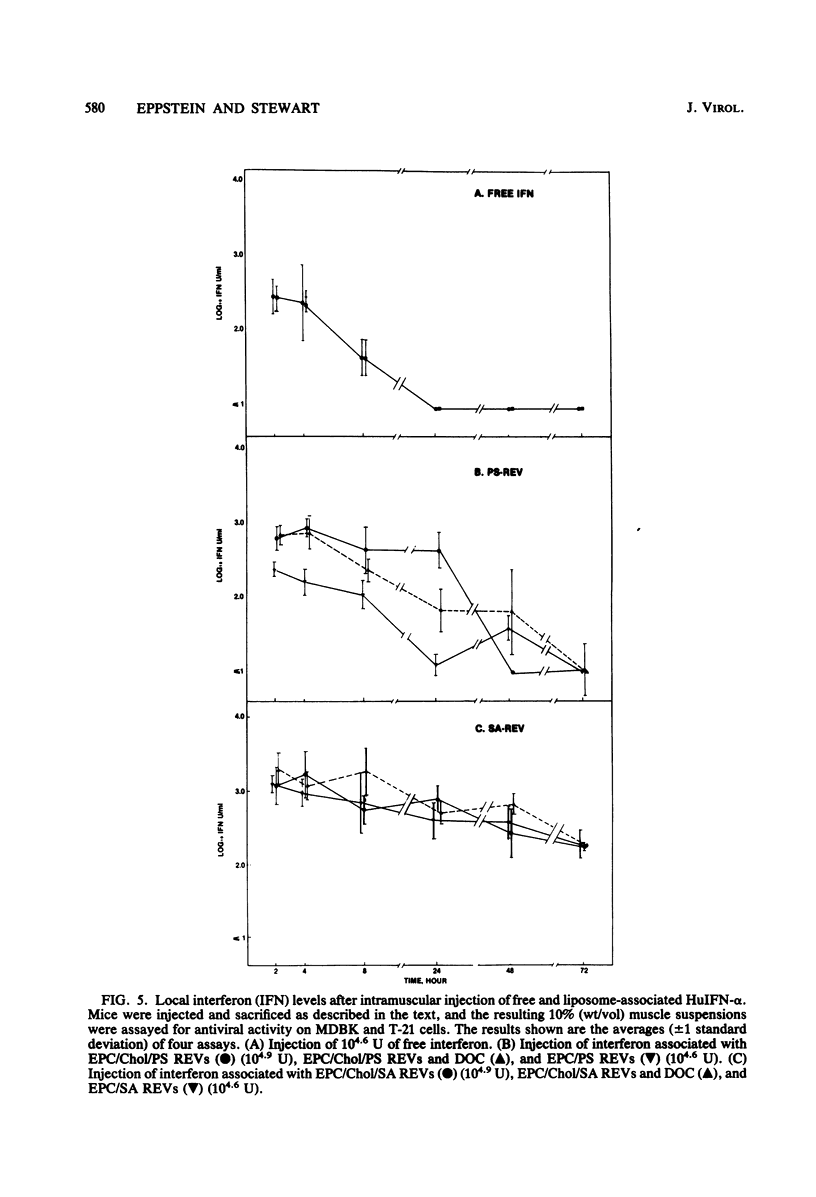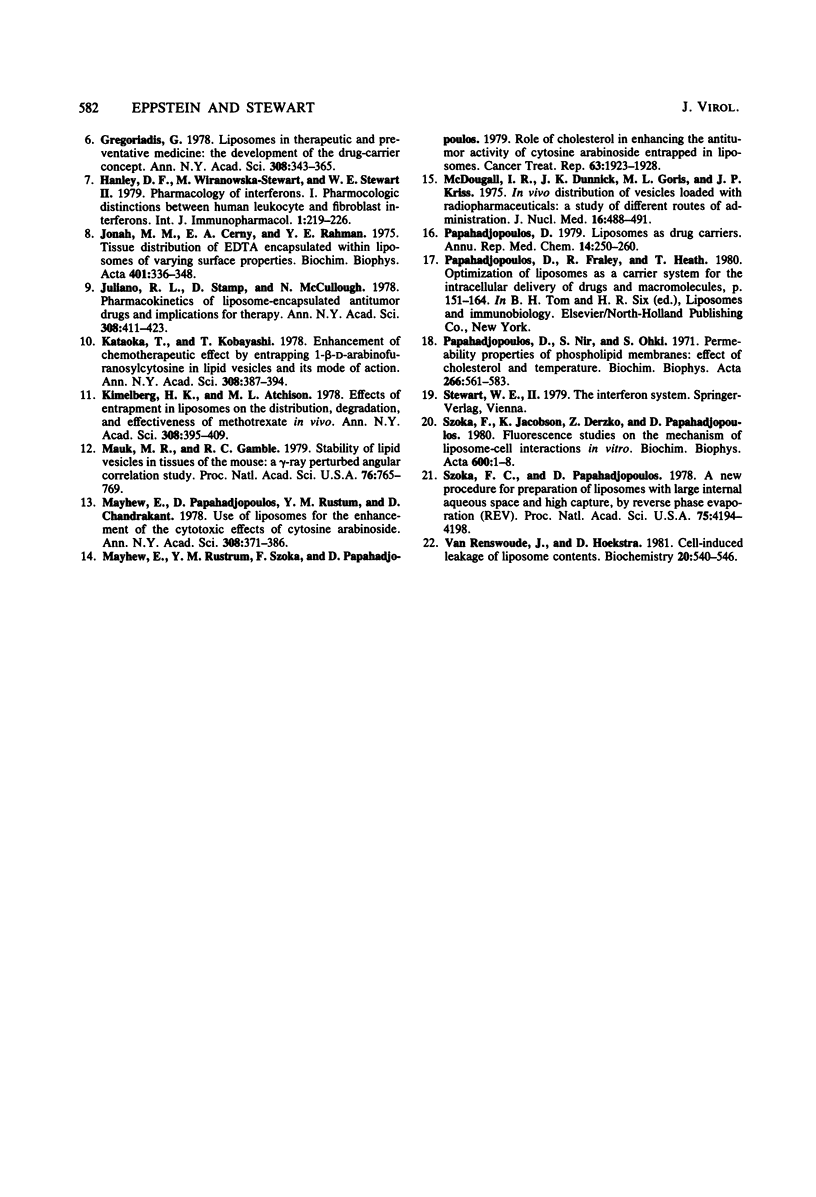Abstract
Human interferon-alpha was associated in different ways with positively (stearylamine) and negatively (phosphatidylserine) charged phosphatidylcholine multilamellar vesicles, depending on the presence or absence of a cholesterol component. Inclusion of cholesterol resulted in interferon that was significantly (P = 0.0001) more deeply internalized within the liposomes, such that detergent disruption was necessary before most of the interferon activity was expressed. Interferon was stably associated with stearylamine-containing liposomes, both with and without a cholesterol component. However, inclusion of cholesterol in the phosphatidylserine-containing liposomes was necessary for stable association of the interferon for more than 2 days at 4 degrees C or for more than 24 h at 37 degrees C. After intramuscular injection into mice, liposome-associated interferon in reverse-phase evaporation vesicles was retained at the local site of injection significantly longer than free interferon. Even 3 days after intramuscular injection, stearylamine-containing liposomes with or without cholesterol resulted in local interferon levels that were comparable to the peak levels obtained 2 to 4 h after free interferon was injected. In contrast, free interferon was not detectable in the local muscles 24 h after injection of 10(4.6) U. Liposomes containing phosphatidylserine and cholesterol resulted in intermediate levels of local interferon retention; without a cholesterol component, phosphatidylserine-containing liposomes resulted in no increased local interferon retention compared with the results when free interferon was injected.
Full text
PDF







Selected References
These references are in PubMed. This may not be the complete list of references from this article.
- Alving C. R., Steck E. A., Chapman W. L., Jr, Waits V. B., Hendricks L. D., Swartz G. M., Jr, Hanson W. L. Liposomes in leishmaniasis: therapeutic effects of antimonial drugs, 8-aminoquinolines, and tetracycline. Life Sci. 1980 Jun 30;26(26):2231–2238. doi: 10.1016/0024-3205(80)90207-6. [DOI] [PubMed] [Google Scholar]
- Anderson P., Vilcek J., Weissmann G. Entrapment of human leukocyte interferon in the aqueous interstices of liposomes. Infect Immun. 1981 Mar;31(3):1099–1103. doi: 10.1128/iai.31.3.1099-1103.1981. [DOI] [PMC free article] [PubMed] [Google Scholar]
- Eppstein D. A., Stewart W. E., 2nd Binding and capture of human interferon-alpha by reverse evaporation vesicles, multilamellar vesicles, and small unilamellar vesicles. J Interferon Res. 1981;1(4):495–504. doi: 10.1089/jir.1981.1.495. [DOI] [PubMed] [Google Scholar]
- Fidler I. J., Raz A., Fogler W. E., Kirsh R., Bugelski P., Poste G. Design of liposomes to improve delivery of macrophage-augmenting agents to alveolar macrophages. Cancer Res. 1980 Dec;40(12):4460–4466. [PubMed] [Google Scholar]
- Fidler I. J., Sone S., Fogler W. E., Barnes Z. L. Eradication of spontaneous metastases and activation of alveolar macrophages by intravenous injection of liposomes containing muramyl dipeptide. Proc Natl Acad Sci U S A. 1981 Mar;78(3):1680–1684. doi: 10.1073/pnas.78.3.1680. [DOI] [PMC free article] [PubMed] [Google Scholar]
- Fidler I. J. Therapy of spontaneous metastases by intravenous injection of liposomes containing lymphokines. Science. 1980 Jun 27;208(4451):1469–1471. doi: 10.1126/science.7384789. [DOI] [PubMed] [Google Scholar]
- Gregoriadis G. Liposomes in therapeutic and preventive medicine: the development of the drug-carrier concept. Ann N Y Acad Sci. 1978;308:343–370. doi: 10.1111/j.1749-6632.1978.tb22034.x. [DOI] [PubMed] [Google Scholar]
- Hanley D. F., Wiranowska-Stewart M., Stewart W. E., 2nd Pharmacology of interferons I. Pharmacologic distinctions between human leukocyte and fibroblast interferons. Int J Immunopharmacol. 1979;1(3):219–226. doi: 10.1016/0192-0561(79)90045-6. [DOI] [PubMed] [Google Scholar]
- Jonah M. M., Cerny E. A., Rahman Y. E. Tissue distribution of EDTA encapsulated within liposomes of varying surface properties. Biochim Biophys Acta. 1975 Sep 2;401(3):336–348. doi: 10.1016/0005-2736(75)90234-5. [DOI] [PubMed] [Google Scholar]
- Juliano R. L., Stamp D., McCullough N. Pharmacokinetics of liposome-encapsulated antitumor drugs and implications for therapy. Ann N Y Acad Sci. 1978;308:411–425. doi: 10.1111/j.1749-6632.1978.tb22038.x. [DOI] [PubMed] [Google Scholar]
- Kataoka T., Kobayashi T. Enhancement of chemotherapeutic effect by entrapping 1-beta-D-arabinofuranosylcytosine in lipid vesicles and its mode of action. Ann N Y Acad Sci. 1978;308:387–394. doi: 10.1111/j.1749-6632.1978.tb22036.x. [DOI] [PubMed] [Google Scholar]
- Kimelberg H. K., Atchison M. L. Effects of entrapment in liposomes on the distribution, degradation and effectiveness of methotrexate in vivo. Ann N Y Acad Sci. 1978;308:395–410. doi: 10.1111/j.1749-6632.1978.tb22037.x. [DOI] [PubMed] [Google Scholar]
- Mauk M. R., Gamble R. C. Stability of lipid vesicles in tissues of the mouse: a gamma-ray perturbed angular correlation study. Proc Natl Acad Sci U S A. 1979 Feb;76(2):765–769. doi: 10.1073/pnas.76.2.765. [DOI] [PMC free article] [PubMed] [Google Scholar]
- Mayhew E., Papahadjopoulos D., Rustum Y. M., Dave C. Use of liposomes for the enhancement of the cytotoxic effects of cytosine arabinoside. Ann N Y Acad Sci. 1978;308:371–386. doi: 10.1111/j.1749-6632.1978.tb22035.x. [DOI] [PubMed] [Google Scholar]
- Mayhew E., Rustum Y. M., Szoka F., Papahadjopoulos D. Role of cholesterol in enhancing the antitumor activity of cytosine arabinoside entrapped in liposomes. Cancer Treat Rep. 1979 Nov-Dec;63(11-12):1923–1928. [PubMed] [Google Scholar]
- McDougall I. R., Dunnick J. K., Goris M. L., Kriss J. P. In vivo distribution of vesicles loaded with radiopharmaceuticals: a study of different routes of administration. J Nucl Med. 1975 Jun;16(6):488–491. [PubMed] [Google Scholar]
- Papahadjopoulos D., Nir S., Oki S. Permeability properties of phospholipid membranes: effect of cholesterol and temperature. Biochim Biophys Acta. 1972 Jun 20;266(3):561–583. doi: 10.1016/0006-3002(72)90001-7. [DOI] [PubMed] [Google Scholar]
- Szoka F., Jacobson K., Derzko Z., Papahadjopoulos D. Fluorescence studies on the mechanism of liposome-cell interactions in vitro. Biochim Biophys Acta. 1980 Jul 16;600(1):1–18. doi: 10.1016/0005-2736(80)90406-x. [DOI] [PubMed] [Google Scholar]
- Szoka F., Jr, Papahadjopoulos D. Procedure for preparation of liposomes with large internal aqueous space and high capture by reverse-phase evaporation. Proc Natl Acad Sci U S A. 1978 Sep;75(9):4194–4198. doi: 10.1073/pnas.75.9.4194. [DOI] [PMC free article] [PubMed] [Google Scholar]
- Van Renswoude J., Hoekstra D. Cell-induced leakage of liposome contents. Biochemistry. 1981 Feb 3;20(3):540–546. doi: 10.1021/bi00506a015. [DOI] [PubMed] [Google Scholar]


